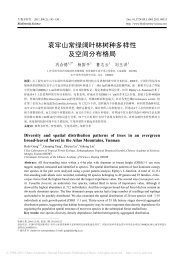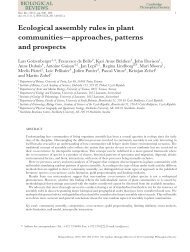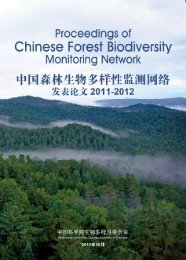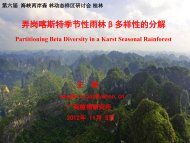the maintenance of species-richness in plant communities
the maintenance of species-richness in plant communities
the maintenance of species-richness in plant communities
Create successful ePaper yourself
Turn your PDF publications into a flip-book with our unique Google optimized e-Paper software.
Ma<strong>in</strong>tenance <strong>of</strong> <strong>species</strong>-<strong>richness</strong> <strong>in</strong> <strong>plant</strong> <strong>communities</strong> I3 5<br />
(g) differences <strong>in</strong> <strong>the</strong> competitive abilities <strong>of</strong> <strong>species</strong> dependent on <strong>the</strong>ir physiological<br />
age coupled with <strong>the</strong> uneven-age structure <strong>of</strong> many populations.<br />
4. The mechanisms listed above do not go far to expla<strong>in</strong> <strong>the</strong> <strong>in</strong>def<strong>in</strong>ite persistence<br />
<strong>in</strong> mixture <strong>of</strong> <strong>the</strong> many <strong>species</strong> <strong>in</strong> <strong>the</strong> most <strong>species</strong>-rich <strong>communities</strong> known.<br />
5. In contrast <strong>the</strong>re seem to be almost limitless possibilities for differences between<br />
<strong>species</strong> <strong>in</strong> <strong>the</strong>ir requirements for regeneration, i.e. <strong>the</strong> replacement <strong>of</strong> <strong>the</strong> <strong>in</strong>dividual<br />
<strong>plant</strong>s <strong>of</strong> one generation by those <strong>of</strong> <strong>the</strong> next. This idea is illustrated for tree <strong>species</strong><br />
and it is emphasized that foresters were <strong>the</strong> first by a wide marg<strong>in</strong> to appreciate its<br />
importance.<br />
6. The processes <strong>in</strong>volved <strong>in</strong> <strong>the</strong> successful <strong>in</strong>vasion <strong>of</strong> a gap by a given <strong>plant</strong><br />
<strong>species</strong> and some characters <strong>of</strong> <strong>the</strong> gap that may be important are summarized <strong>in</strong><br />
Table 2.<br />
7. The def<strong>in</strong>ition <strong>of</strong> a <strong>plant</strong>’s niche requires recognition <strong>of</strong> four components:<br />
(a) <strong>the</strong> habitat niche,<br />
(b) <strong>the</strong> life-form niche,<br />
(c) <strong>the</strong> phenological niche, and<br />
(d) <strong>the</strong> regeneration niche.<br />
8. A brief account is given <strong>of</strong> <strong>the</strong> patterns <strong>of</strong> regeneration <strong>in</strong> different k<strong>in</strong>ds <strong>of</strong><br />
<strong>plant</strong> community to provide a background for studies <strong>of</strong> differentiation <strong>in</strong> <strong>the</strong> regeneration<br />
niche.<br />
9. All stages <strong>in</strong> <strong>the</strong> regeneration-cycle are potentially important and examples <strong>of</strong><br />
differentiation between <strong>species</strong> are given for each <strong>of</strong> <strong>the</strong> follow<strong>in</strong>g stages:<br />
(a) Production <strong>of</strong> viable seed (<strong>in</strong>clud<strong>in</strong>g <strong>the</strong> sub-stages <strong>of</strong> flower<strong>in</strong>g, poll<strong>in</strong>ation and<br />
seed-set),<br />
(b) dispersal, <strong>in</strong> space and time,<br />
(c) germ<strong>in</strong>ation,<br />
(d) establishment, and<br />
(e) fur<strong>the</strong>r development <strong>of</strong> <strong>the</strong> immature <strong>plant</strong>.<br />
10. In <strong>the</strong> conclud<strong>in</strong>g discussion emphasis is placed on <strong>the</strong> follow<strong>in</strong>g <strong>the</strong>mes:<br />
(a) <strong>the</strong> k<strong>in</strong>ds <strong>of</strong> work needed <strong>in</strong> future to prove or disprove that differentiation <strong>in</strong><br />
<strong>the</strong> regeneration niche is <strong>the</strong> major explanation <strong>of</strong> <strong>the</strong> <strong>ma<strong>in</strong>tenance</strong> <strong>of</strong> <strong>species</strong>-<strong>richness</strong><br />
<strong>in</strong> <strong>plant</strong> <strong>communities</strong>,<br />
(b) <strong>the</strong> relation <strong>of</strong> <strong>the</strong> present <strong>the</strong>sis to published ideas on <strong>the</strong> orig<strong>in</strong> <strong>of</strong> phenological<br />
spread,<br />
(c) <strong>the</strong> relevance <strong>of</strong> <strong>the</strong> present <strong>the</strong>sis to <strong>the</strong> discussion on <strong>the</strong> presence <strong>of</strong> cont<strong>in</strong>ua<br />
<strong>in</strong> vegetation,<br />
(d) <strong>the</strong> co-<strong>in</strong>cidence <strong>of</strong> <strong>the</strong> present <strong>the</strong>sis and <strong>the</strong> emerg<strong>in</strong>g ideas <strong>of</strong> evolutionists<br />
about differentiation <strong>of</strong> angiosperm taxa, and<br />
(e) <strong>the</strong> importance <strong>of</strong> regeneration-studies for conservation.<br />
I am grateful to Dr A. S. Watt for <strong>in</strong>spir<strong>in</strong>g my <strong>in</strong>terest <strong>in</strong> <strong>the</strong> regeneration <strong>of</strong> vegetation, to Dr E. W.<br />
Jones for references on <strong>the</strong> fruit<strong>in</strong>g <strong>of</strong> forest trees, and to Drs R. S. Clymo, E. I. Newman and R. W.<br />
Snaydon for criticiz<strong>in</strong>g a first draft <strong>of</strong> this paper. Miss S. M. Bishop drew Figs. 1-6 and 8-10.
















